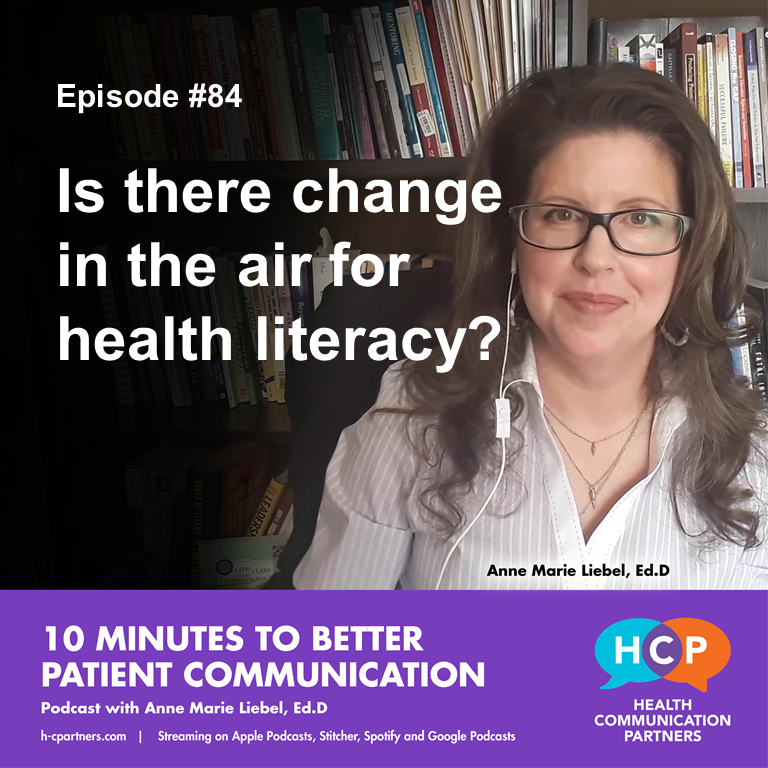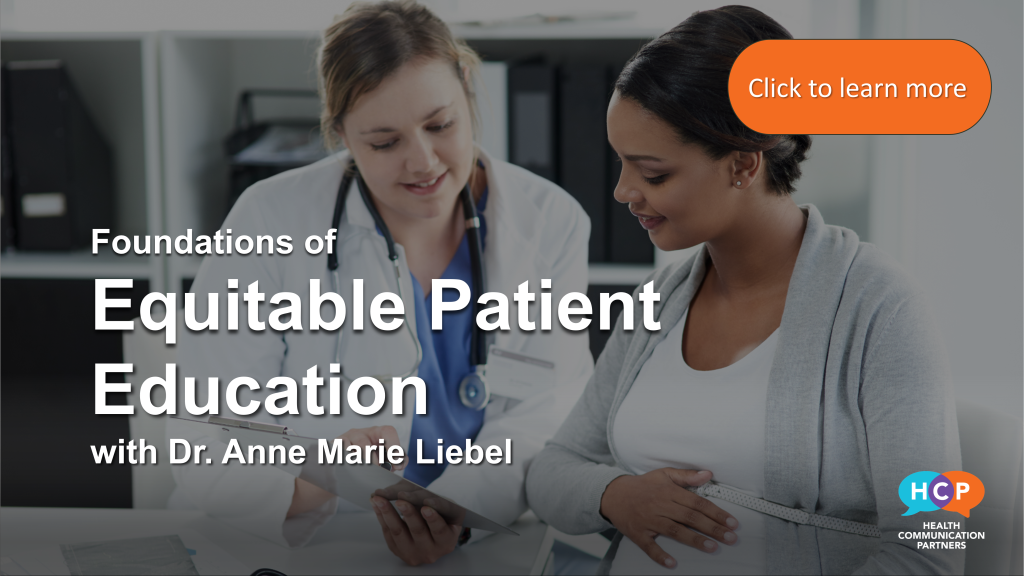This health literacy month has been an exciting one. There may be some change in the air! Find out what’s going on and why now may be an important moment for health literacy as a field.

I love health literacy! I love the idea. I love that the field exists, and it has its own journal and its own conferences. People who care about health literacy care about educating. And they care about literacy! So if you’re a person who cares about health literacy, I love you, too.
I’m cautiously optimistic after having been involved in a lot of things this month, October being health literacy month. Lotta health literacy activity going on. And I’m optimistic: is there change in the air for health literacy?
Hi everyone welcome to 10 Minutes to Better Patient Communication from Health Communication Partners. I’m Dr. Anne Marie Liebel and I want to welcome our first ever sponsor! Its Maven Roth Group. And I’m really glad for you to meet them–i’ll tell you the story. You know that we just celebrated our third anniversary of the podcast series. And before that, the third anniversary of the Health Communication Partners website. Well before that, I knew Maven Roth Group! Because I had started my company, Health Communication Partners, and I knew I was going to need a brand. And I have never had to think about branding before in my life. I’m an educator, I’m a researcher, I’m an academic, I don’t have to think about branding! So I asked around for recommendations and what I went to mavenroth.com I was a little intimidated because they have some big clients. And I thought, they’re never going to pay attention to me. I’m a one-woman show.
But I called them anyway and I’m glad that I did, because they listened, and they asked really good questions. And they understood that I’m trying to do something here–it’s not your typical look at health communication, it’s not your typical look at patient education, it’s not your typical look at health literacy. And so they got that, they took the time to get that. And one of the results was the Health Communication Partners logo, which you’ve seen. It’s those gorgeous overlapping conversation bubbles.
 And I’m obsessed with this logo. So I’m really glad to introduce Maven Roth to you, because no matter how big or small your organization is Maven Roth is going to work with you to find out your core values–what sets you apart–and then they’re going to help you communicate that to the world. So welcome aboard, Maven Roth! Go to mavenroth.com to get started.
And I’m obsessed with this logo. So I’m really glad to introduce Maven Roth to you, because no matter how big or small your organization is Maven Roth is going to work with you to find out your core values–what sets you apart–and then they’re going to help you communicate that to the world. So welcome aboard, Maven Roth! Go to mavenroth.com to get started.
So I’m cautiously optimistic: is there change in the air for health literacy? I have three reasons to think so. The first is the new definition. You heard me, last summer I broadcast about the Health and Human Services was issuing a a call to the public for input into a redefinition of health literacy. So it was unveiled this summer and I’ll go ahead and put the link in the notes. And if you haven’t seen it now there are two definitions for health literacy. The first one has to do with individuals. It kind of looks like what we’ve seen before.
But the second one has to do with organizations. And I was just at, virtually at, a recent health literacy conference. Here is its title, it’s long: Health Literacy in Action/Health Literacy Annual Research Conference. Those typically are two different things, but they combined this year and it was great. And there was some excitement over the second definition, over the second part of the definition, the organizational side.
Is this a step in a helpful direction? I’m hopeful!
Of course, thinking about the organizational side of health literacy isn’t new. Even without that snazzy definition, researchers have been looking closely at the literacy demands of health systems for a long time. If you’re interested in this, and you want to get some real richness, go check out Papen and Walters from 2008. It’s a longitudinal study out of the northwest of England and it’s full full full of delicious data. So I’m intrigued to that this is getting some mainstream attention now, because it’s been going on but it hasn’t necessarily been front-and-center. So the conference organizers encourage all of us attendees put our thinking caps on around this. So I’m going to jump in, and I’m eager to see what others in the health literacy community come up with.
And I think that this is in a part of signal of the maturation of the field, which brings me to my second reason that I’m optimistic. At the end of the health literacy conference, the organizers encouraged the attendees to tell them–tell the leaders–what the leaders have been missing. Like who they’re not seeing or hearing, in their efforts to lead the health literacy field in reducing health disparities through research, theory, practice, and policy.
I found this to be a very leaderful move. I think it’s a smart move. It reminds me of when you know, companies have a new product, and they spend a session or more, saying, ‘all right so what are all the things that are wrong with this? What are all the ways that this can fail?’ And so in that sense I also think it’s probably a good thing to think about doing more than just once, right? I think this can be an ongoing process.
Because there’s the suggestion that, Hey, maybe we could be doing better. And in Academia and fields like this, it’s harder to course-correct, I think. Because health literacy, as it stands now, even with the new definitions, it’s a concept that many people all around the world have put much energy and resources and time and wisdom into, for many years. So saying ‘what are we missing’ is a brave move.
I think it’s exciting especially because it opens up the possibility of looking within. And by this I mean: fields across the health sector are taking hard looks at some of their taken-for-granted ways of working. This might be health literacy’s time.
But doing that that looking within is not going to be smooth sailing right? Statues don’t fall easily! There’s an enormous weight of tradition.
Also, when you’re committed to working for Equity–like pretty much the whole health literacy community is–it can be threatening even to entertain the thought that the call might be coming from inside the house. That some of the things you’ve always been doing are unintentionally working against you.
This is not a trend, this kind of thinking, this reckoning. Just like looking at the organizational side of health literacy isn’t a recent thing. People have been asking hard questions of health literacy since the field began. Before the field was called health literacy. But these voices have not been mainstream.
And that brings me to my third reason to be optimistic: there are ways forward. There are ways to do this. And some of them have already been being done, but more on the margins.
So yeah, I’m sharing some of my thoughts at the conference organizers, and more publicly in a few upcoming journal articles. Because, like I said at the start: I believe in health literacy as a concept and a field, and I believe in the people in the field of health literacy. I’ve been listening hard for years to this field, and I’ll continue to listen for the ways that people are finding to say what’s not typically been said, or show what’s not typically been seen.
Health literacy is interdisciplinary. And this could be the moment where our field decides our diversity is our strength.
But this can’t be done piecemeal; there’s too much at stake. Any efforts to really question assumptions in health literacy, in order to remove obstacles to equity, need to be done intentionally, systematically. They need to be research-based. And fortunately, there is a whole body of knowledge on how to do this kind of work, this reflection, this questioning of assumptions, in the fields that I come from. And that’s what this whose series is based on, really! So if this is important to you, let’s talk, ‘cuz it’s important to me. You can find me at healthcommunicationpartners.com, click on contact. Find me on Twitter at amliebel. Connect with me on linked. Or write me at Anne Marie at H-C Partners.com. This has been 10 Minutes to Better Patient Communication from Health Communication Partners. I’m Dr. Anne Marie Liebel. Thanks for listening!
